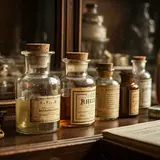
Vintage Hacks for Modern Wounds

The following advice for wound care comes from Receipts and Remedies, published in 1908.
Nowadays, there are primarily two types of liquid bandages: skin protectants and suture replacements. Skin protectants are over-the-counter topical solutions, like gels and sprays, designed to shield minor wounds, like scrapes. Suture replacements, on the other hand, are medical-grade adhesives to close more serious wounds, including surgical incisions and certain internal organ cuts. When you purchase a liquid bandage at the drugstore today, it is the descendant of other, similar products that were much less stable and much more caustic. From Receipts and Remedies:
Abrasions - (1) - An abrasion of the skin should be washed and then covered with pliable collodion, which forms an artificial skin over the spot. Take collodion, one ounce; castor oil and soft turpentine, each eight grains. Apply this with a camel's hair brush, putting on two or three times. The coats dry and form a protective covering over the sore. (2) - A healing lotion for abrasions, scratches and little cuts is made of : spirits of camphor, one ounce; glycerine, one-fourth drachm; borax, one-eighth drachm; carbolic acid, five grains. Apply to the sore twice a day.
If much skin has been lost and the part bleeds freely, a paste of glycerine and boric acid, or one of glycerine and subnitrate of bismuth may be laid on and covered with collodion.
For minor skin abrasions, this guide says, a simple home remedy involves cleaning the wound and applying a protective coating. So far, this is clear enough, but the ingredients may seem unfamiliar to modern readers: a mixture of collodion, castor oil, and turpentine can be brushed onto the abrasion to form an artificial skin. Alternatively, a soothing lotion is presented, containing spirits of camphor, glycerine, borax, and carbolic acid, which can be applied twice daily. For more severe abrasions with significant skin loss and bleeding, a paste of glycerine and boric acid, or glycerine and bismuth subnitrate, can be applied and covered with collodion. Modern approaches will certainly be more comfortable, but it is fascinating to trace the origin of our modern medical products.